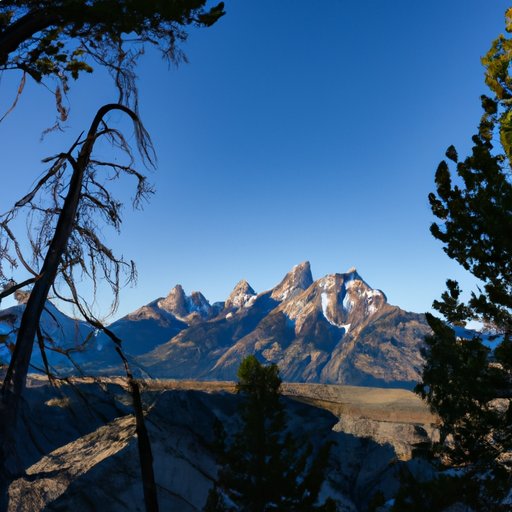I. Introduction
The US is home to an abundance of natural landscapes and outdoor wonders. In order to preserve these precious areas and make them accessible to visitors, the National Park System was established. As a traveler, it is important to know how many national parks are in the US in order to plan your next adventure accordingly.
II. Counting the Parks: An Overview of How Many National Parks are in the US
The US National Park System began in 1916 with the creation of the National Park Service, which was established to protect and preserve the country’s most significant natural landmarks. Since then, the park system has grown to include an impressive 63 national parks.
However, the National Park System encompasses more than just national parks. It also includes national monuments, national historic sites, and other protected areas. When including these additional categories, the total number of sites managed by the National Park Service reaches 423.
III. America’s National Treasures: A Complete Guide to the Country’s National Parks
National parks in the US are known for their awe-inspiring natural beauty and rich biodiversity. Some of the most popular national parks include Yellowstone, Yosemite, Grand Canyon, and Zion National Park. These parks offer a range of experiences, from hiking and camping to wildlife watching and scenic drives.
Visitors to national parks can expect to see a variety of wildlife, such as grizzly bears, wolves, and bison. Additionally, many national parks are home to unique geological formations, such as towering rock formations, geysers, and waterfalls.
The best times to visit national parks vary based on location and climate. Summer is typically the busiest season, but parks such as Yosemite and Yellowstone are best visited in the offseason to avoid crowds and enjoy more peaceful surroundings.
IV. Exploring the Great Outdoors: A Look at the Vastness of the US National Parks
The US national parks are known for their vastness and geographic diversity. The largest national park in the US is Wrangell-St. Elias in Alaska, which covers over 13 million acres. Meanwhile, the smallest national park is Hot Springs National Park in Arkansas, which covers just over 5,550 acres.
Depending on the park, visitors can enjoy a range of activities, from hiking and fishing to kayaking and guided tours. It is important to practice responsible outdoor exploration in order to preserve the delicate ecosystems and ensure the safety of visitors.
V. The Evolution of America’s National Parks: From Yosemite to Acadia
The establishment of national parks in the US was met with controversy in the early years. Many people believed that resources should be used for economic development rather than preserving natural landmarks. However, over time, national parks have become a symbol of national pride and have played an important role in preserving the country’s natural and cultural heritage.
Some of the most significant national parks in the US include Yosemite, which was established in 1890 and is known for its towering peaks and waterfalls, and Acadia National Park, which was established in 1916 and features a rugged coastline and diverse wildlife.
VI. The Top US National Parks You Need to Visit In Your Lifetime
With so many national parks to choose from, it can be difficult to know where to start. Some of the top-rated national parks based on visitor reviews include Great Smoky Mountains, Zion, and Grand Teton National Park. These parks offer a range of unique attractions, from iconic rock formations to scenic drives and stunning vistas.
When visiting national parks, it is important to maximize your experience by planning ahead and researching the best hikes, scenic drives, and activities. Many national parks offer ranger-led tours and educational programs, which can provide a deeper understanding of the park’s history and significance.
VII. Beyond the Famous National Parks: Discovering Hidden Gems in the US
While famous national parks draw large crowds each year, there are many hidden gems in the US that offer just as much natural beauty and outdoor adventure. Some lesser-known national parks include Congaree National Park in South Carolina, which features extensive old-growth forests, and Isle Royale National Park in Michigan, which is located on a remote island in Lake Superior and is known for its unique wildlife.
Discovering less-visited national parks allows for a more unique and personal experience, and also supports the preservation of these less-visited natural areas.
VIII. Numbers in Nature: A Statistical Breakdown of the US National Parks
Interesting statistics about the US national parks include that they encompass over 84 million acres, receive over 330 million visitors annually, and generate over $40 billion in economic benefits to local communities.
This data is significant because it highlights the important role that national parks play in preserving natural areas and supporting local economies. National parks are a true symbol of American pride and a valuable resource for future generations to enjoy.
IX. Conclusion
Visiting national parks in the US is not only a great way to experience the natural beauty of the country, but it also supports the preservation of these precious areas. By understanding how many national parks are in the US and the different types of parks available, travelers can make informed decisions when planning their next outdoor adventure.
Whether you choose to explore well-known national parks or discover hidden gems, responsible outdoor exploration is essential to protect these natural resources for generations to come.
